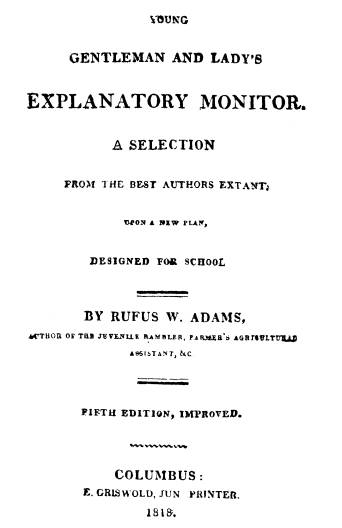Ohio History Journal
OHIO STATE ARCHAEOLOGICAL AND
HISTORICAL
SOCIETY
REVIEWS, NOTES AND COMMENTS
BY THE EDITOR
AN EARLY OHIO SCHOOL BOOK
Through the kindly interest of Mr. Kora
F. Briggs,
the Society has come into the
possession of an interest-
ing school book published in Columbus
in the year 1818,
two years after this city became the
seat of the state
government. From the copyright notice
it appears that
this book was first published in 1814
by the author, Ru-
fus W. Adams. On a page preceding the
preface are
published two recommendations, one by
Jacob Lindley,
"President of the College at
Athens, Ohio," and one by
Andrew Wylie, "President of the
College at Washing-
ton, Pennsylvania." These two
recommendations bear
the dates respectively of March 10,
1814, and Septem-
ber 10, 1817. As will be seen from the
title page of the
book this copy is one of the
"Fifth Edition, Improved."
The following preface is not without
interest as giving
in brief compass the views of an old-time
schoolmaster
and his object in publishing the
volume. It reads as fol-
lows:
PREFACE
Although selections of excellent matter
made for the im-
provement and instruction of young
persons are numerous, and
many of them executed in such a manner
as to reflect the highest
honor upon the authors; yet it occurred
to me that a school book
on the plan of the following pages
might be of service in the
(138)
|
Reviews, Notes and Comments 139 YOUNG GENTLEMAN AND LADY'S EXPLANATORY MONITOR. A SELECTION FROM THE BEST AUTHORS EXTANT UPON A NEW PLAN, DESIGNED FOR SCHOOL BY RUFUS W. ADAMS, AUTHOR OF THE JUVENILE RAMBLER, FARMER'S AGRI?? ASSISTANT, &c FIFTH EDITION, IMPROVED. COLUMBUS: E. CRISWOLD, JUN PRINTER. 1818. |
|
|
140 Ohio Arch. and Hist. Society
Publications
great business of educating youth.
Having in a long course of
teaching school, observed in many
instances the inattention of my
scholars to the subjects they were
perusing, on account of the
definition of terms, and that many of
them who were called good
readers retained not any, or at most but
very few of the ideas
that were suggested in the composition
they had been perusing, I
became persuaded that a work containing
the definitions of the
most important words, would in some
degree remedy that defect.
The pieces chosen for this collection
are such as paint virtue and
magnanimity in the most conspicuous
manner, and by frequent
perusal, are calculated to instil those
principles into the minds of
youth; at the same time they display an
abhorrence and detesta-
tion of vice.
No expression or sentiment, that might
gratify a corrupt
mind, or offend a chaste ear has been
permitted to find a place in
the following work.
To lead the young mind in the path of
virtue, and to aid in-
structors in the arduous business of
educating youth, were the
motives which led to the production of
this work.
If this edition should be well received,
and should, even in
a small degree, prove a public benefit,
the author will think him-
self well remunerated for his trouble,
and that his time has been
well employed.
The preface is followed by
"Observations on the
Principles of Good Reading." Then
follow the selec-
tions. These, without apparent
exception, are of a
serious character. Some would not pass
muster for a
school reader today. Others are well
chosen and may
still be read with interest and profit.
The text is accompanied with notes
explaining the
meaning of every word that might not be
readily under-
stood by the pupil. It was evidently
the thought of the
author that a clear understanding of
the text was one
of the best guides to the development
of a taste for
reading and the most effective
expression in reading
aloud.
The book numbers 260 pages and is in an
excellent
Reviews, Notes and Comments 141
state of preservation. The title page,
which is repro-
duced in facsimile, carries the imprint
of one of the
very early publishers of Columbus.
PORTRAIT OF SIMON KENTON.
In Filson Club Publications No. 17 the
artist who
painted the portrait of Simon Kenton is
spoken of as
Louis Morgan. The contribution is by
General Samuel
W. Price, himself an artist, and an
authority on the
subject treated in his carefully
prepared monograph
entitled The Old Masters of the Blue
Grass. His
sketch of Morgan is a very interesting
one, but it dif-
fers in some important particulars from
the contribu-
tion to this issue of the QUARTERLY by Mr. Walter D.
McKinney, who gives the name of the
artist of the
Kenton portrait as James Morgan and
sustains this
claim by a manuscript letter from
Thomas W. Cridland
who made the frame for the portrait of
Kenton pre-
sented to the Ohio State Archaeological
and Historical
Society. The differences between the
sketch in the
Filson Publications and that included
in Mr. McKin-
ney's address will be subject to future
comparisons and
an effort made to determine beyond
question the name
of the artist.
IN OUR NEXT ISSUE.
Brief contributions entitled The
Descendants of Te-
cumseh and Ezra Meeker, The Ohioan will appear in
the next issue of the QUARTERLY; also
acknowledgment
of a gift to the Society by Miss Rachel
Trimble.
